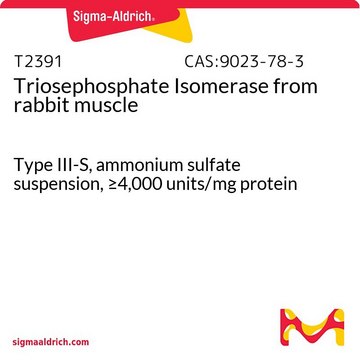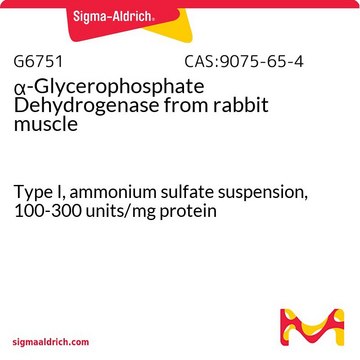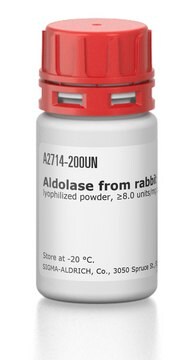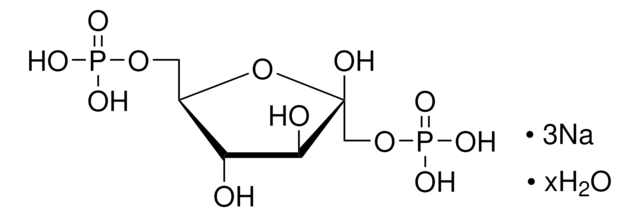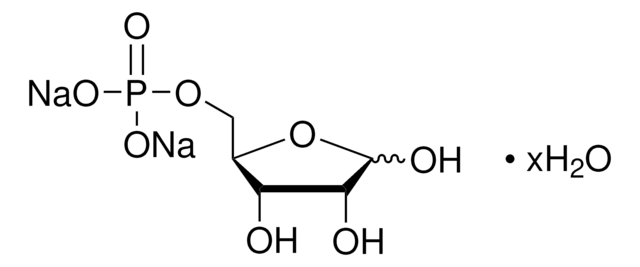G1881
α-Glycerophosphate Dehydrogenase-Triosephosphate Isomerase from rabbit muscle
Type III, ammonium sulfate suspension
Synonym(s):
GDH/TIM, α-GDH-TPI
Sign Into View Organizational & Contract Pricing
All Photos(1)
About This Item
MDL number:
UNSPSC Code:
12352204
NACRES:
NA.54
Recommended Products
biological source
rabbit muscle
Quality Level
type
Type III
form
ammonium sulfate suspension
GDH activity
75-200 units/mg protein (biuret)
TPI activity
750-2000 units/mg protein
storage temp.
2-8°C
Looking for similar products? Visit Product Comparison Guide
Related Categories
General description
Research area: Neuroscience
α-Glycerophosphate Dehydrogenase-Triosephosphate isomerase (α-GDH-TPI or GDH/TIM) is an enzyme mixture of α-glycerophosphate dehydrogenase (GDH) and triosephosphate isomerase (TPI).
α-Glycerophosphate Dehydrogenase-Triosephosphate isomerase (α-GDH-TPI or GDH/TIM) is an enzyme mixture of α-glycerophosphate dehydrogenase (GDH) and triosephosphate isomerase (TPI).
Application
α-Glycerophosphate Dehydrogenase-Triosephosphate Isomerase from rabbit muscle has been used in spectrophotometric aldolase assay and fructose 2,6 bisphosphate assay. It has also been used in erythrocyte transketolase (ETK) activity to study the prevalence of and factors associated with thiamin deficiency in obese.
α-glycerophosphate dehydrogenase was used in 2-deoxy-ribose 5-phosphate aldolase (DERA) cleavage (retroaldol) assay.
Biochem/physiol Actions
α-Glycerophosphate dehydrogenase (α-GPDH) has the ability to produce reactive oxygen species (ROS), that is induced by Ca2+.
α-glycerophosphate dehydrogenase catalyzes the conversion of dihydroxyacetone to glycerol phosphate. α-Glycerophosphate dehydrogenase (α-GPDH) has the ability to produce reactive oxygen species (ROS), that is induced by Ca2+. Triosephosphate isomerase (TPI) is an essential enzyme in the glycolytic pathway, responsible for converting dihydroxyacetone phosphate (DHAP) into glyceraldehyde-3 phosphate (GAP). TPI′s role is crucial in enhancing the efficiency of the catabolic process within glycolysis. However, a deficiency in TPI can lead to glycolytic enzymopathies, rare genetic disorders characterized by neurologic dysfunction and hemolytic anemia.
Packaging
(Sold on the basis of α-GDH units.)
Unit Definition
(α-GDH) One unit will convert 1.0 μmole of dihydroxyacetone phosphate to α-glycerophosphate per min at pH 7.4 at 25 °C.
(TPI) One unit will convert 1.0 μmole of D-glyceraldehyde 3-phosphate to dihydroxyacetone phosphate per min at pH 7.6 at 25 °C.
Physical form
Mixed crystalline suspension in 3.2 M (NH4)2SO4, with 0.05 g/L EDTA, pH 6.0
Storage Class
12 - Non Combustible Liquids
wgk_germany
WGK 2
flash_point_f
Not applicable
flash_point_c
Not applicable
Choose from one of the most recent versions:
Already Own This Product?
Find documentation for the products that you have recently purchased in the Document Library.
Customers Also Viewed
The role of mitochondrial dehydrogenases in the generation of oxidative stress
Adam-Vizi V and Tretter L
Neurochemistry International, 62(5), 757-763 (2013)
C R Hussey et al.
European journal of biochemistry, 80(2), 497-506 (1977-11-01)
A preparation of phosphofructokinase from rabbit skeletal muscle is described which exploits the association-dissociation properties of the enzyme. Phosphofructokinase to prepared is partially phosphorylated and may be fractioned into three distinct species with sedimentation coefficients of 30 S, 18 S
Identification of an anaerobically induced phosphoenolpyruvate-dependent fructose-specific phosphotransferase system and evidence for the Embden-Meyerhof glycolytic pathway in the heterofermentative bacterium Lactobacillus brevis.
Saier M H, et al.
Journal of Bacteriology, 178(1) (1996)
Grace DeSantis et al.
Bioorganic & medicinal chemistry, 11(1), 43-52 (2002-12-07)
2-Deoxyribose-5-phosphate aldolase (DERA, EC 4.1.2.4) catalyzes the reversible aldol reaction between acetaldehyde and D-glyceraldehyde-3-phosphate to generate D-2-deoxyribose-5-phosphate. It is unique among the aldolases as it catalyzes the reversible asymmetric aldol addition reaction of two aldehydes. In order to expand the
Wenguang Liang et al.
FASEB journal : official publication of the Federation of American Societies for Experimental Biology, 25(2), 497-504 (2010-10-07)
The pentose phosphate pathway (PPP) confers protection against oxidative stress by supplying NADPH necessary for the regeneration of glutathione, which detoxifies H(2)O(2) into H(2)O and O(2). RPE functions in the PPP, catalyzing the reversible conversion of D-ribulose 5-phosphate to D-xylulose
Articles
Instructions for working with enzymes supplied as ammonium sulfate suspensions
Our team of scientists has experience in all areas of research including Life Science, Material Science, Chemical Synthesis, Chromatography, Analytical and many others.
Contact Technical Service